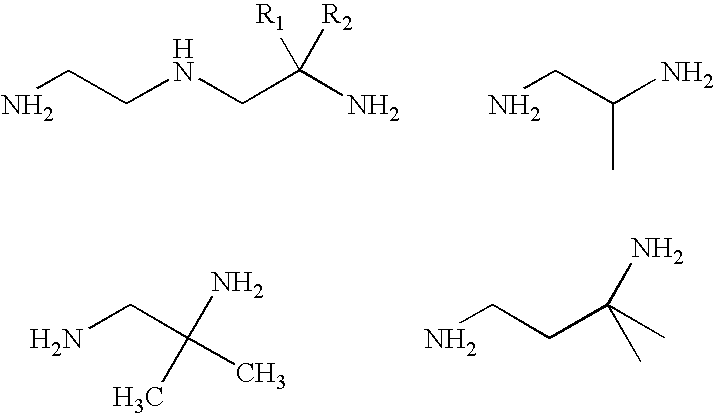Treated port fuel injectors
a technology of fuel injectors and port ports, which is applied in the direction of fuel injector pumps, machines/engines, mechanical equipment, etc., can solve the problems of reducing fuel flow, affecting engine performance, and affecting engine performance, so as to improve engine performance and prevent or reduce fuel flow disruptions.
- Summary
- Abstract
- Description
- Claims
- Application Information
AI Technical Summary
Benefits of technology
Problems solved by technology
Method used
Image
Examples
example 1
Port Fuel Injectors Treated with the Reaction Product of PIBSA / TEPA, a Mannich Base Detergent, and a Spark Ignition Fuel
[0040]A first reaction product of polyisobutylene-substituted succinic anhydride (PIBSA) and TEPA was obtained by reacting PIBSA and TEPA in a molar ratio of 1:1 at a temperature of 165-170° C. A second reaction product of PIBSA and TEPA was obtained by reacting the PIBSA and TEPA in a molar ratio of 1.6:1 at a temperature of 165-170° C. Water generated during each of the reactions was removed. For testing purposes, the reaction products were diluted by 50% with Aromatic Solvent. The first and second reaction products were separately blended with HiTEC® 6560 Detergent, a Mannich base detergent available from Afton Chemical Corporation, Richmond, Va., U.S.A., in the amounts indicated in Tables 1 and 2, and the mixtures were added to gasoline at a treat rate of 80 ptb.
[0041]Results for the PFI rig test are reported in Tables 1-2 below.
[0042]
TABLE 1PFI DepositsTest Ru...
example 2
Port Fuel Injectors Treated with “DACH Mannich” and a Spark Ignition Fuel
[0045]The Mannich condensation reaction product of: a polyamine having a sterically-hindered primary amino group; a hydrocarbyl-substituted hydroxyaromatic compound; and an aldehyde (“DACH Mannich”), diluted to contain 25 wt % solvent, was added to the base fuel at a treat rate of 80 ptb. The DACH Mannich was prepared by reacting 1,2-diaminocyclohexane (“DAC”) as a mixture of trans and cis isomers thereof, polyisobutylene-substituted ortho-cresol (“PIB-cresol”), and formaldehyde (“FA”). The PIB-cresol was formed by alkylating ortho-cresol with a polyisobutylene having a number average molecular weight of approximately 900. The DAC, PIB-cresol, and FA were reacted in the following manner in a resin flask equipped with mechanized stirring, nitrogen feed, a Dean-Stark trap, and a heating mantle. Solvent (Aromatic-100) and the PIB-cresol were introduced to the flask and the mixture was heated to 40° C., with a slig...
example 3
Comparative Example
[0049]Port fuel injectors were subjected to the PFI rig test, first using the base fuel alone, to establish a baseline plugging rate, then using a fuel including one or more conventional additives, and then once again using the base fuel alone. Additives, treat rates, and results are reported in Tables 4-6 below.
[0050]
TABLE 4Treat RatePFI DepositsTest RunFuel Composition(ptb)(plugging rate, %)0Base Fuel24.111600 MW805.1Polyetheramine* &20Diethylamide ofIsostearic Acid2Base Fuel27.5*“Actaclear 2400” available from Bayer Material Science
[0051]
TABLE 5Treat RatePFI DepositsTest RunFuel Composition(ptb)(plugging rate, %)0Base Fuel24.11OGA 402*807.82Base Fuel24.4*detergent available from Chevron
[0052]
TABLE 6Treat RatePFI DepositsTest RunFuel Composition(ptb)(plugging rate, %)0Base Fuel30.91Mannich of PIB8010.1phenol w / DMAPA*2Base Fuel17.8*“HiTEC ® 4980 Detergent” available from Afton Chemical Corporation
[0053]As can be seen from the results in Tables 4-6, while conventi...
PUM
| Property | Measurement | Unit |
|---|---|---|
| temperature | aaaaa | aaaaa |
| temperature | aaaaa | aaaaa |
| temperature | aaaaa | aaaaa |
Abstract
Description
Claims
Application Information
 Login to View More
Login to View More - R&D
- Intellectual Property
- Life Sciences
- Materials
- Tech Scout
- Unparalleled Data Quality
- Higher Quality Content
- 60% Fewer Hallucinations
Browse by: Latest US Patents, China's latest patents, Technical Efficacy Thesaurus, Application Domain, Technology Topic, Popular Technical Reports.
© 2025 PatSnap. All rights reserved.Legal|Privacy policy|Modern Slavery Act Transparency Statement|Sitemap|About US| Contact US: help@patsnap.com

